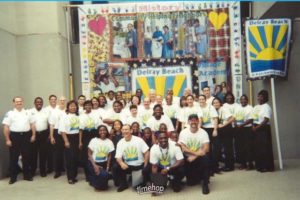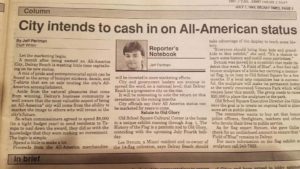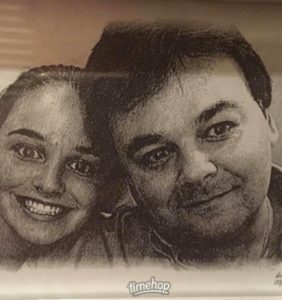
The 2001 Delray Beach All America City contingent. A quilt entitled “A Patchwork of Pride” accompanied the group which was ably led by Joe Gillie.
It’s been 20 years since Delray Beach won its second All America City Award in 2001.
It was a big deal back then.
More than 100 people made the trip from Delray Beach to Atlanta to attend a three day competition which included presentations from 30 really cool cities from across the country.
I was reminded of that magical time last week when we sat down to watch a new documentary on HBO entitled “Our Towns”—which is based on the wonderful book by James and Deborah Fallows who crisscrossed America in a small plane to learn and then share the stories of cities that rarely if ever make the news.
It’s a heartwarming documentary at a time when we need a reminder that there are places in this world and in this country that are working. There are still communities that share, care and dare to do big things—or little things together.
If you watch the documentary or read the book, you’ll want to visit Eastport, Maine, Redlands, California, Bend, Oregon and Charleston, West Virginia.
Five years ago, the Fallows who are accomplished journalists, put a call out to their readers: tell us about your towns. The responses poured in.
The writers had a hunch that beneath the headlines of division and strife that somewhere in America things were working, problems were being solved, opportunities were being created and hope was being rewarded. They were right.
They learned that developing a sense of community and a common language of change can help people and towns find a different path to a better future.
Along the way, we meet people tackling racial division, homelessness, polarization and economic despair by employing a can-do collaborative spirit.
And I thought, these are the traits celebrated by the All America City Award.
Over the years, the award itself has changed and is now focused on education. But back in 1993, when Delray won its first award and 20 years ago when it won its second before becoming the first city to win three awards with another win in 2017, the All America City Award took a broader look; education was still a component, but so was how communities worked to enhance their youth and senior populations among other topics.
In 2001, Delray Beach won the award by spotlighting three programs.
The Youth Enrichment Vocational Program provided high-risk youth between the ages of 14 and 23 with opportunities to learn job skills. The program was founded by Officer Johnny Pun and Community Service Officer Fred Glass. It was a bold and ambitious effort that led to the Delray Beach Police Department becoming the first PD in Florida to charter a school.
Community Neighbors Helping helped minority senior citizens living in one of the city’s poorest areas to improve their health, receive services and meet people outside their established environment. Finally, the city, in conjunction with the school district and community, had developed The Village Academy, a public school regulated by members of the community instead of a school board. The vision was to address the needs of at-risk elementary students living in low-income neighborhoods. This too was a bold and ambitious vision and was spearheaded by a community planning process known as the Southwest Plan.
Today, a mere 20 years later, only The Village Academy remains.
The charter school had a nice run before finally closing its doors. Johnny Pun, the energetic young officer, who dreamed of teaching kids to fix cars instead of stealing them died tragically in a motorcycle crash. Those who knew and loved Johnny —and if you knew Johnny you loved him— will never forget where they were when they received word of his accident. His bright light went out without warning. Some losses are just incalculable. I remember hearing the news and being unable to catch my breath. How can someone so alive be gone from us and his family forever? His loss leveled so many.
I’m not sure what happened with Community Neighbors Helping or its founder Edith Thompson, who was a full-time postal worker who spent her off hours tending to her neighbors. I remember Edith going to a local Publix to collect bread which she would give out to people who stopped by the National Church of God on Southwest 13th Street every morning. That initial effort grew to more than 20 local churches and senior centers.
Running a non-profit on a shoe string while working full time and raising three children is almost impossible to fathom.
I searched for Ms. Thompson and found her on Facebook. I’m not sure what happened to Community Neighbors Helping. The last news story was written 19 years ago. Efforts and people come and go. That’s life I suppose.
The world is a constant whirlwind of change. People and efforts can be lasting or ephemeral, but they all matter.
The stories in “Our Towns” and in Our Town matter too.
We tend to get wound up about the latest project or passing controversy and I get it. Change can be difficult. It’s also a constant.
But these other efforts matter too. They are often lost and forgotten and that’s not good and it’s not healthy.
It can be easy to forget that communities can work.
America is not just talking heads screaming at each other on cable news or blowhard politicians pandering to the base.
Its neighbors taking bread to church so the hungry can have something to eat. Its officers looking at crime stats and saying there’s got to be a better way than just making arrests and throwing away the key.
It’s a community gathering in a A/C deprived church and dreaming of a different kind of school and making it happen.
That’s America. That’s also the real Delray.
So if you ask me what I miss, it’s not necessarily the old-time businesses that sometimes close—that happens. Although, I wish I could have one more breakfast at the counter of Ken and Hazel’s. I also wish I could go inside Boston’s on The Beach and be greeted by my friend Perry just one more time.
What I miss are the special people, the can-do spirit and the community based efforts that made me and so many others fall in love with Delray.
I miss the sense of community and of possibility—the belief that every year would be better than the last. For years and years that’s how it went.
The progress you see today has its roots in those special days. The problems you see today are because we have strayed from the formula that made this place so special.
The ingredients were simple:
Put Delray first.
Take your ego elsewhere.
Don’t be afraid to experiment.
Don’t be afraid to say yes, to seek out new voices and to try. That spirit gave us Old School Square, a revitalized downtown, historic districts, new schools and some cool special events.
Somewhere beneath the vitriol and division, that heart still beats.
It’s the part of our DNA we would be wise to rediscover. Until then, let’s find the magic wherever we can. And let’s separate the signal from the noise—don’t let the naysayers get you down.
I’m reminded of the old song That’s life.
“And as funny as it may seem some people get their kicks
stomping on a dream. But I don’t let it, let it get me down
Cause this fine old world, it keeps spinnin’ around.”
Yes it does. Thank goodness.
I wanted to note the loss of two very special people in recent weeks.
Dr. Henrietta Smith passed April 21. She was 98 and extraordinary.
Dr. Smith was an educator, librarian and storyteller. She edited four editions of the Coretta Scott King Award Collection published by the American Library Association. She won the 2011 Coretta Scott King-Virginia Hamilton Award for Lifetime Achievement for her body of work and lasting literary contributions.
She taught at FAU and later became the first Black professor at USF in Tampa. In 2006, at age 84, she accompanied a medical team on a trip down the Amazon River telling stories to the children in the small villages they visited. Like I said, she was something.
She was also the mother of retired Delray Police Officer Robin Smith, who had a fine career in our city.
We’d see Dr. Smith around town over the years at community events and she was always kind, gracious and understated. She will be missed and always remembered. A true legend.
We also lost Ben Ruby on April 25.
Ben was a wonderful man.
Ben was married to Susan Ruby our terrific former City Attorney. I got to know Ben over the years and he was always great to talk to.
Just a nice man, with a great sense of humor and an unforgettable smile. He and Susan were married for 55 years and set a standard for us all. This was a love affair for the ages and it was great to be a witness to it.
Five years ago, we were blessed to attend a 50th wedding anniversary celebration for Ben and Susan. We were so fortunate to share in a celebration of a special marriage. It takes a lot for the spouse of a public servant to loan their loved ones to the cause of bettering the community. During late night commission meetings I would often look at Susan and think of Ben waiting for her at home.
Ben was a smart man and an accomplished technologist for DHL and the Miami Herald. He was active in the Sunrise Kiwanis Club in Delray Beach and an all-around good guy. He and Susan (whom I adore) are in our prayers.


 Delray Beach won another All America City Award last week and that’s a good excuse to write a whole lot of nice things about Janet Meeks.
Delray Beach won another All America City Award last week and that’s a good excuse to write a whole lot of nice things about Janet Meeks.

